Topic – D&T Cooking and Nutrition
Food preparation is part of Design and Technology; children have three opportunities each year to prepare food.
This term, the children made overnight oats using a variety of skills:
- snipping
- weighing (using digital scales)
- measuring liquids
- use measuring spoons
- claw chopping grip
- mixing
- arranging toppings
First, we read the recipe together, discussing some elements that might be changed. We also discussed hygiene and how we can stay safe in the kitchen.
The children enjoyed a great deal of success, building on previous food preparation learning.




Children took their food home to try then returned to school to evaluate the product. We considered the success of the product and how close it was to the recipe. We discussed challenging techniques and any changes we would consider for next time.
Help at home by watching some of these fantastic cooking videos. If you try any of these recipes at home, we’d love to see the results.
Computing
In computing this week, we have been developing a pedometer. Pedometers are devices that track the number of steps you take. They contain an internal mechanism or arm that moves up and down in response to the motion of your hips. With each step, your body tilts to one side and your leg swings forward. As your body shifts the other way, your other leg moves forward as well. Each tilt of your hips, along with the forward swing of your legs, is counted as a step.
In our first lesson, we developed our code – the children needed to fix a few problems with their initial algorithms. We had to use decomposition to help us debug it. Then, we downloaded our pedometer code to our micro:bits and checked to see if they worked. We had do some trial and errors and tweak the sensitivity of our pedometers.
We then put our pedometers to the test outside.






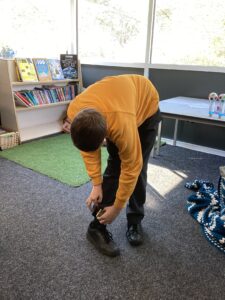
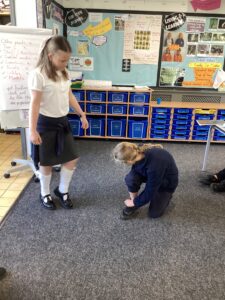
Living and Learning
Feeling good and being me
We have been having a big focus on peer pressure and how this may impact on someone’s wellbeing. We are all clear on what peer pressure is and why it might happen. It is crucial that we speak up if we feel that is happening in any aspect of our lives (at school, home or online). Children were very mature and were very respectful throughout our discussions.

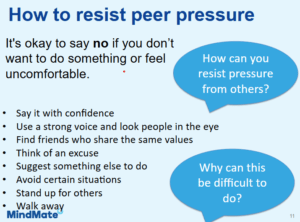
Help at home – discuss peer pressure with your child. Ask them what they can do should they be worried about something.
Easter Egg Hunt
We have been learning about Easter using the book, Story of Easter by Fiona Boon. We’ve enjoyed painting Easter pictures, making Easter cards and going on spring walks looking for signs of new life.









Today we went on an Easter Egg hunt in the Nursery Garden. We thought about where the eggs were hidden using our new maths vocabulary ‘under, on top, behind, next to and in front of.’ We had to find 4 eggs each!
After the holidays we will be looking at the Number 4 and The Very Hungry Caterpillar by Eric Carle. We’ll also have some exciting visitors in Nursery, can you guess what they might be?
Help at Home: Look out for minibeasts! Have a look under logs and stones, or a walk round the garden and see which insects and other Minibeasts you can find.
A Happy and Healthy School
On Friday, Year 3 took time to organise and clean up our school grounds. We had noticed that lots of equipment was missing, and that there was a significant amount of rubbish around the edges of our school field. So, we took matters into our own hands and got to work! The children were absolutely fantastic and showed good teamwork and perseverance. Here are the results from their hard work – we now have lots of equipment to keep us happy and healthy during break and lunch times!
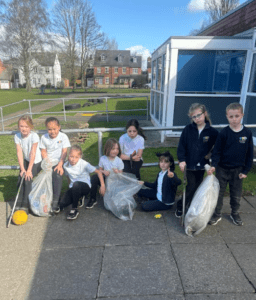
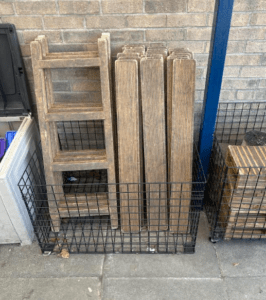

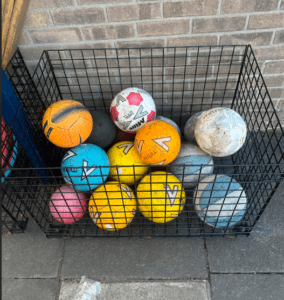
The Tiny Seed
This week our focus book as been The Tiny Seed by Eric Carle.

In the story we follow a tiny seed traveling on its journey through the seasons. We went on our own seasons walk to find signs of spring, we spotted blossom, buds, daffodils, insects and leaves. We even stopped to listen to the sound of lots of birds singing.

Our word of the week was miniscule: something that is even smaller than tiny.
Maths
In Maths, we’ve been doubling!

Poetry Picnic
Each week we learn a new poem and recite it every day. By saying the poem out loud, we can focus on the sounds and rhythm of each word or line. We talk about how this can help us become better readers. This week’s poem is called Hungry Birdies.
Hungry Birdies
I have built a little nest,
look inside, look inside.
Hungry birdies with their beaks,
open wide, open wide.
And the little birdies grow,
day by day by day.
‘Till they spread their wings and fly,
far away, far away.
We talk about how a poem sometimes has rhyming words and sometimes doesn’t. Can your child tell you the rhyming words in this week’s poem? We also talk about how a poem can have a fast rhythm or a slow rhythm.
Have a happy and healthy weekend and thank you as always for your support.
Mrs. Kendrew, Mrs. Rippon, Mrs. Small and Mr. Smith
P.E.
This week in P.E. we’ve been practising our coordination skills with the quoits. We rolled the quoits from the top of our head to our toes and named our different body parts. We worked with a partner, rolling the quoits to each other, then balanced them on our head as we moved around the hall. The children showed brilliant listening skills as well as perseverance.








The Knitted Bible
We had a fantastic trip out this afternoon to St Joseph’s Catholic Church and our own St James’ Church to see scenes from the bible represented in knitted form.
We were warmly received at St Joseph’s and there were lots of activities for us to do. We even got the chance to have a look around the church – many of our children hadn’t been inside a catholic church before. We found many similarities with our own church and we followed the Stations of the Cross around, something we have been looking at in detail during our RE lessons this half term.





We then went on to St James’, where Val was delighted to see us. We were able to explore the church the knitted scenes and draw on our own knowledge of the Easter story. Before we left, we took time to reflect on what has been a busy week of assessment and Val said a prayer for the children, staff and our school community. The children chose a knitted gift to take away with them too.







There were many scenes; we particularly enjoyed the Zacchaeus scene that links to our Christian Value of Honesty and David and Goliath, our school bible story.









The Knitted Bible display will continue to be open to the public until Sunday 6th April. Further details can be found here: https://www.dioceseofleeds.org.uk/event/the-knitted-bible-comes-to-wetherby/
Visit to the see The Knitted Bible
We had a great time on our trip to St James’ Church to see the bible stories represented in knitted scenes.
We recognised the scenes from Holy Week as well as the story of Zaccheus which is one of the stories associated with our Christian Values.


We were also gifted a crochet decoration to take home to remind us of our wonderful morning.

The Knitted Bible display will continue to be open to the public until Sunday 6th April. Further details can be found here: https://www.dioceseofleeds.org.uk/event/the-knitted-bible-comes-to-wetherby/
Mouse hunting at St James’ Church
On our visit to St James’ Church today we hunted for mice by Robert “Mouseman” Thompson. It took some perseverance but we managed to find all 12 mice. Next time you pop in to church ask your children to show you them all!


